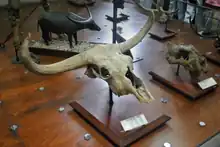Bos palaesondaicus
Bos palaesondaicus occurred on Pleistocene Java (Indonesia) and belongs to the Bovinae subfamily. It has been described by the Dutch paleoanthropologist Eugène Dubois in 1908.[1] The holotype of Bos palaesondaicus is a skull from Trinil. This species is the likely ancestor to the banteng (Bos javanicus).[2][3]
| Bos palaesondaicus Temporal range: Pleistocene | |
|---|---|
 | |
| Bos palaesondaicus skull at the Bandung Geological Museum. | |
 | |
| Partial skull at Naturalis. | |
| Scientific classification | |
| Domain: | Eukaryota |
| Kingdom: | Animalia |
| Phylum: | Chordata |
| Class: | Mammalia |
| Order: | Artiodactyla |
| Family: | Bovidae |
| Subfamily: | Bovinae |
| Genus: | Bos |
| Species: | †B. palaesondaicus |
| Binomial name | |
| †Bos palaesondaicus (Dubois, 1908) | |
| Synonyms | |
|
Bibos palaesondaicus Dubois, 1908 | |
References
- Dubois, E. (1908). Das Geologische Alter der Kendengoder TrinilFauna. Tijdschr. Kon. Ned. Aardr. Gen., ser. 2, vol. 25, pp. 12351270, pl. 39.
- Hooijer, D.A. (1958a). Fossil Bovidae from the Malay archipelago and the Punjab, Zoologische Verhandelingen van de Museum Leiden 38:1–112.
- Hooijer, D. A. (1958b). Sexual differences in the skull of fossil and recent banteng. Mammalia 22:73-75.
This article is issued from Wikipedia. The text is licensed under Creative Commons - Attribution - Sharealike. Additional terms may apply for the media files.